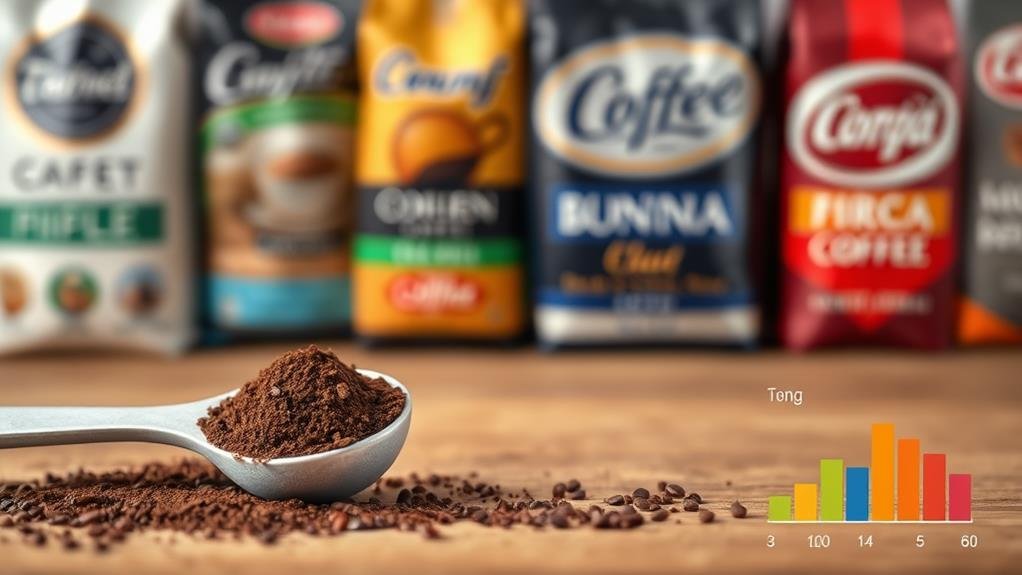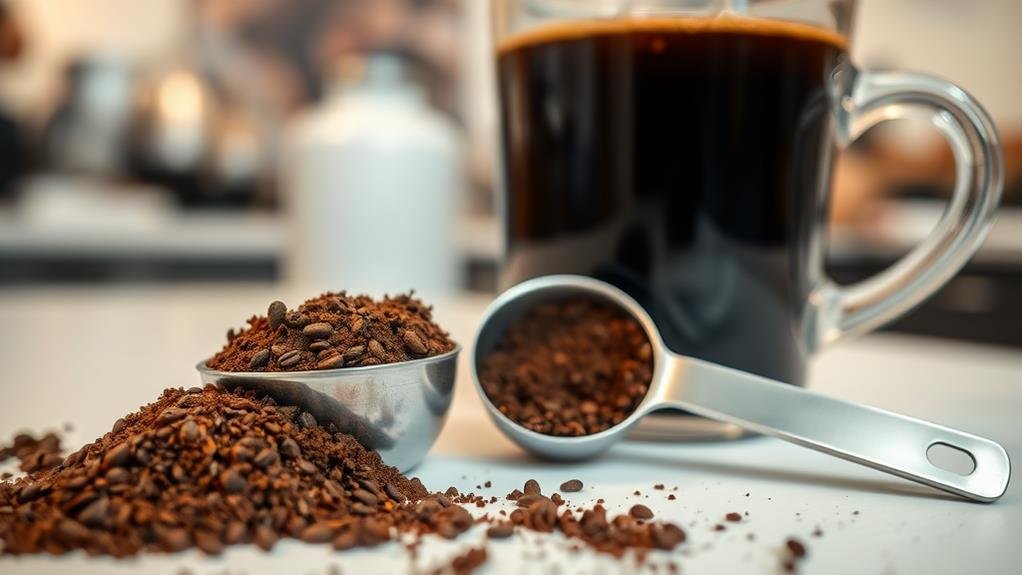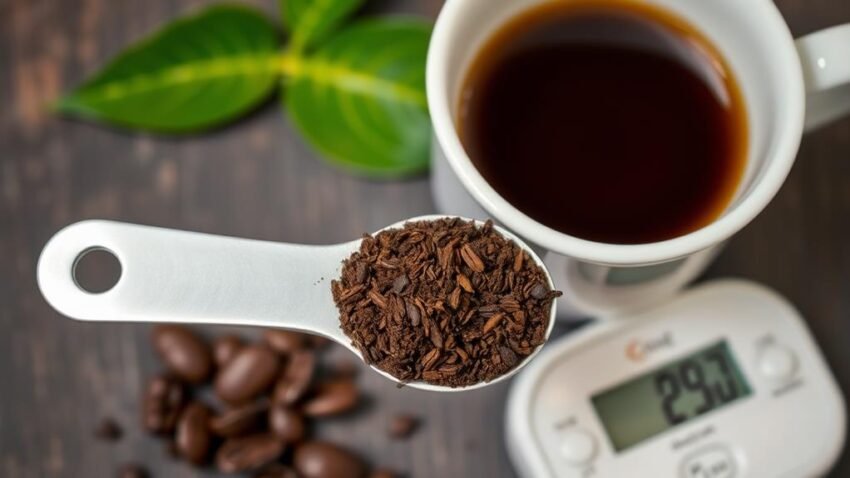As someone who loves coffee, I've often wondered how much caffeine is actually in that tablespoon I scoop into my brewer each morning. It turns out that a tablespoon of ground coffee typically contains between 30-50 mg of caffeine, but this amount can vary significantly based on factors like the type of coffee bean and the grind size. Lighter roasts tend to pack more caffeine than darker ones, and finer grinds release even more during extraction. This variability makes it intriguing to explore further—especially if you're trying to manage your daily caffeine intake. Just how much caffeine are you really getting in your cup?
Safe Daily Caffeine Intake

When it comes to consuming coffee, understanding safe daily caffeine intake is important. For most healthy adults, the recommended safe daily caffeine intake is up to 400 mg per day. This limit helps guarantee that you can enjoy your coffee without experiencing adverse effects.
However, some individuals need to be more cautious about their caffeine intake. Pregnant or nursing women, for instance, should limit their daily dose to 200 mg of caffeine. Adolescents aged 12-18 are advised to consume less than 100 mg per day.
Additionally, certain health conditions can impact the safe daily caffeine intake. If you have conditions like acid reflux, overactive bladder, glaucoma, or epilepsy, you may need to further limit your caffeine consumption.
It's also important to take into account how other substances can interact with caffeine. Excessive alcohol consumption combined with caffeine can lead to dehydration, so it's essential to drink responsibly and stay hydrated.
Side Effects of Excessive Caffeine
Excessive caffeine intake can lead to a range of unpleasant side effects. If you consume too much caffeine, you might find it harder to sleep and experience restlessness. Additionally, decaf coffee contains around 2 mg of caffeine per cup, which makes it a suitable option for those sensitive to caffeine and can help mitigate these side effects decaf coffee production. Other potential side effects include irritability, dizziness, heartburn, and an increased heart rate.
Caffeine also acts as a diuretic, which means it can cause dehydration if you don't drink enough water to compensate for the loss of fluids. Additionally, high caffeine consumption can raise blood pressure levels, which is a concern for people with pre-existing heart conditions or hypertension.
It's important to be aware of these side effects so you can manage your caffeine intake effectively. If you start to feel any of these symptoms, it's a good idea to cut back on how much caffeine you're consuming. If the adverse effects persist or worsen, it's advisable to consult a healthcare provider for guidance.
Caffeine Content in Coffee Types

When it comes to the caffeine content in different types of coffee, I find it interesting to compare brewed coffee, espresso shots, and cold brew. Each of these methods yields a distinct amount of caffeine due to variations in brewing techniques and coffee-to-water ratios. For instance, a typical 8-10 oz cup of brewed coffee contains around 60-120 mg of caffeine, while an espresso shot packs about 60-70 mg in just 1 oz, and cold brew can vary widely depending on steeping time and concentration. The variety of coffee beans used, such as Arabica coffee's unique flavors, can also influence the overall caffeine content in each brew.
Brewed Coffee Caffeine
Brewed coffee is one of the most common ways people consume their daily dose of caffeine. When it comes to understanding the caffeine content in brewed coffee, it's important to know that a typical 8 oz. cup contains around 80-100 mg of caffeine. However, this amount can vary significantly based on several factors such as the type of coffee bean, the roast level, and the brewing method used.
For instance, different beans can naturally have higher or lower concentrations of caffeine. Similarly, a darker roast might have slightly less caffeine than a lighter roast because some caffeine is lost during the roasting process. The brewing method also plays a role; methods like French press tend to yield more caffeinated coffee compared to drip brewing.
It's worth noting that brewed coffee generally has more caffeine than other types of coffee, such as instant coffee or decaffeinated brewed coffee. Understanding these variations helps individuals monitor their overall caffeine intake more effectively. By being aware of how much caffeine is in each cup, you can make informed choices about your daily consumption. This knowledge is particularly useful for those who need to manage their caffeine levels for health reasons or personal preference.
Espresso Shot Caffeine
Moving from the broader context of brewed coffee, let's focus on a more concentrated form of coffee: the espresso shot. Espresso shots are highly concentrated and pack a noteworthy amount of caffeine into a small volume. Typically, a single shot of espresso, which is usually 1 ounce, contains about 63 milligrams of caffeine. This is considerably higher than the caffeine content found in brewed coffee per ounce.
Espresso-based drinks like lattes or cappuccinos can vary significantly in their overall caffeine content depending on the number of shots used. For instance, a double espresso shot would contain around 126 milligrams of caffeine, providing an even stronger kick than a single shot.
Understanding the caffeine content in an espresso shot is essential for managing your daily caffeine intake effectively. If you're someone who consumes multiple espresso-based drinks in a day, being aware of these figures can help you stay within your desired limits. This knowledge is particularly important for those who are sensitive to caffeine or have specific health considerations related to their caffeine consumption. By knowing exactly how much caffeine is in each shot, you can better regulate your intake to meet your needs.
Cold Brew Caffeine
If you're seeking a caffeine boost without the intense flavor of espresso, cold brew coffee is an excellent option. Cold brew coffee is known for its higher caffeine concentration compared to regular brewed coffee. A typical 8 oz. cup of cold brew can contain anywhere from 153 to 238 mg of caffeine.
The process of making cold brew involves steeping coffee grounds in cold water for an extended period, which results in a strong and smooth coffee concentrate. This method allows for a higher extraction of caffeine from the coffee beans. The steeping time and coffee-to-water ratio can notably affect the final caffeine content, so these variables can be adjusted to suit personal preference.
For those seeking a potent caffeine boost with a milder flavor profile, cold brew is a popular choice. Unlike espresso, which can be quite bitter and concentrated, cold brew offers a smoother taste experience while still delivering a substantial amount of caffeine. This makes it ideal for consumers who want to enjoy the benefits of caffeine without the intense flavor associated with other types of coffee.
Factors Affecting Caffeine Levels
When it comes to the caffeine content in a tablespoon of coffee, several factors play a pivotal role. The type of coffee bean used is one of the primary factors affecting caffeine levels. Robusta beans, for instance, contain more caffeine than Arabica beans. This difference profoundly impacts the overall caffeine content in brewed coffee.
Another vital factor is the roast type. Lighter roasts generally have higher caffeine levels compared to darker roasts, as some caffeine is lost during the roasting process. Additionally, the grind size of the coffee can influence how much caffeine is extracted. A finer grind can lead to more caffeine being released into the brew.
The brewing method also plays a substantial role in determining caffeine levels. Different methods extract caffeine at varying rates. For example, methods that involve longer steeping times or higher water temperatures tend to extract more caffeine.
Understanding these factors helps determine the caffeine content in a tablespoon of coffee accurately. While it can range from 60-100 mg depending on these variables, knowing how each factor contributes can guide you in managing your caffeine intake effectively. By considering these elements, you can better predict and control the amount of caffeine in your coffee.
Caffeine in Popular Coffee Brands

Let's take a closer look at the caffeine content in popular coffee brands. When it comes to your morning cup, knowing how much caffeine you're getting can be essential. For example, if you're a fan of Dunkin Donuts, their brewed coffee contains 210 mg of caffeine in a medium cup. This is relatively moderate compared to some other options.
If you prefer Starbucks, the caffeine content can vary significantly depending on the drink. A Grande Pike Place roast from Starbucks packs a hefty 310 mg of caffeine, making it one of the higher-end options. On the other hand, Starbucks' Americano provides 284 mg of caffeine, which is still substantial but slightly less than their Pike Place roast.
Dunkin Donuts' iced coffee also stands out with 297 mg of caffeine per serving. This highlights that even within the same brand, different preparations can result in notably different caffeine levels. Understanding these differences can help you make informed choices about your daily coffee intake and make sure you're not overloading on caffeine without realizing it. Whether you're grabbing a quick cup from Dunkin Donuts or savoring a Starbucks brew, being aware of these caffeine levels is crucial to managing your energy boost effectively.
Caffeine Comparison Across Beverages
Comparing the caffeine content across different beverages can be eye-opening, especially when you consider the varying amounts in a tablespoon of coffee. Understanding these differences helps in monitoring your daily caffeine intake more accurately.
- Brewed Coffee: A standard 8 oz cup of brewed coffee contains about 95 mg of caffeine, higher than the 30-40 mg found in a tablespoon of ground coffee. This variation is due to factors like coffee bean type, roast level, and brewing methods.
- Instant Coffee: Instant coffee usually has around 63 mg of caffeine per 2g serving. While this is less than brewed coffee, it's still more than what you'd find in a single tablespoon.
- General Understanding: Knowing the caffeine content in different types of coffee and brewing methods allows you to make informed choices about your consumption.
When you look at these comparisons, it becomes clear that even small differences in preparation or type of coffee can impact your overall caffeine intake significantly. For example, if you're using a tablespoon of ground coffee for a French press versus an espresso, the brewing method will affect the final amount of caffeine in your beverage. This awareness helps you manage your caffeine intake better and avoid potential side effects from excessive consumption.
Calculating Caffeine in Your Cup

To accurately calculate the caffeine in your cup, you need to take into account several main factors. The amount of caffeine in a tablespoon of ground coffee can vary, typically ranging from 30-50 mg, but this can be influenced by the type of coffee bean and grind size.
When brewing your coffee, the method you use plays a significant role. For instance, a French press will generally extract more caffeine than a drip coffee maker due to the immersion of the grounds in water. The water-to-coffee ratio is another essential factor; more coffee relative to water will result in a stronger brew with higher caffeine content.
Using a standard coffee scoop (about 2 tablespoons) can help you gauge the amount of caffeine in your brew. If you're aiming to manage your caffeine intake per day, knowing how much coffee you're using is necessary. Experimenting with different brewing techniques and measurements can help you adjust the amount of caffeine in your cup to suit your preferences. By understanding these variables, you can better control the amount of caffeine you consume from your daily cups of coffee. This guarantees you get the desired energy boost without exceeding safe limits.
Conclusion
To sum up, understanding the caffeine content in a tablespoon of coffee is essential for managing daily intake. An interesting statistic: if you use two tablespoons of ground coffee per cup, you could be consuming around 60-100 mg of caffeine. This knowledge helps you stay within safe daily limits and avoid side effects. By adjusting your coffee-to-water ratio and choosing the right roast, you can tailor your caffeine intake to suit your needs effectively.

